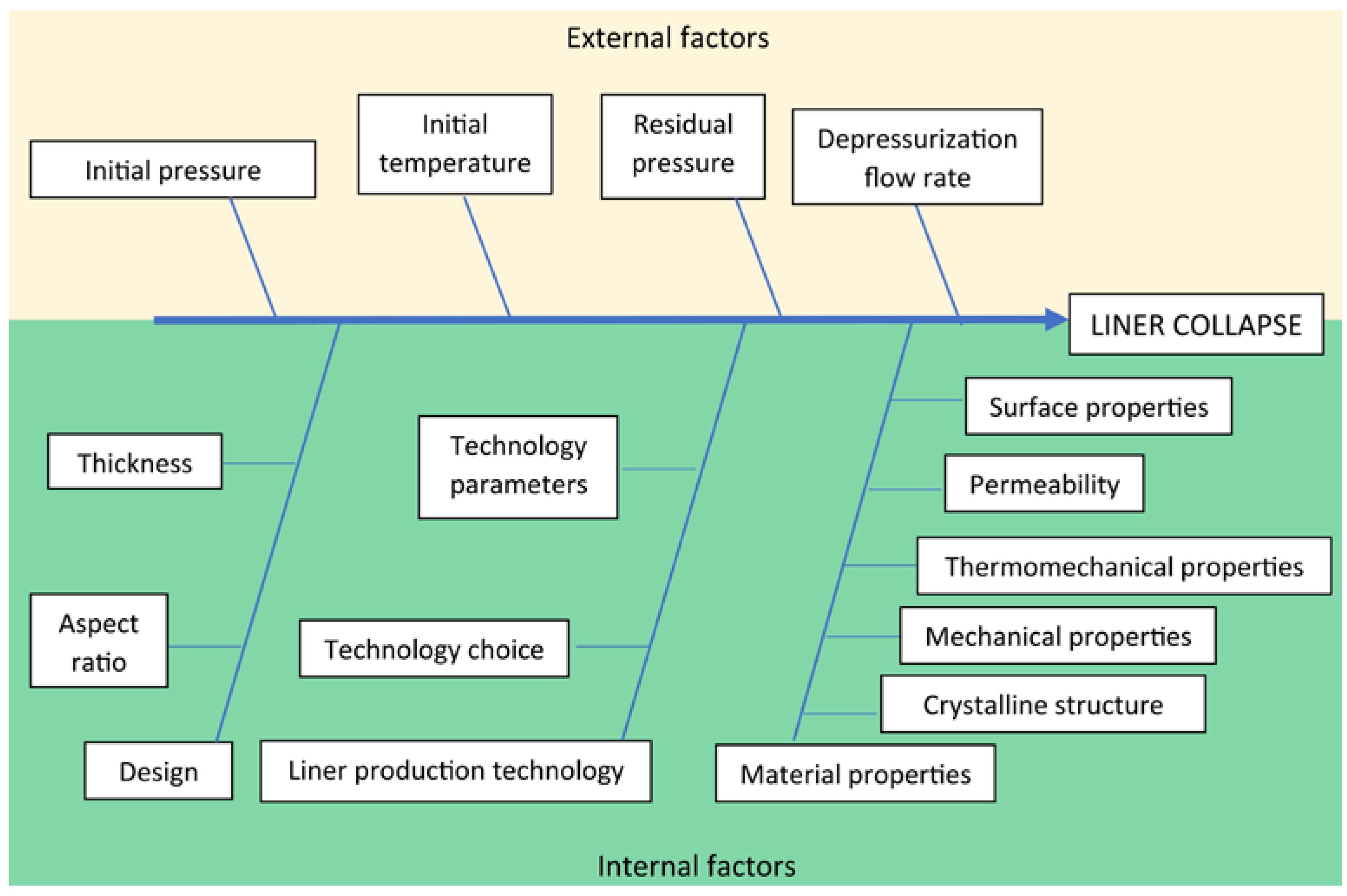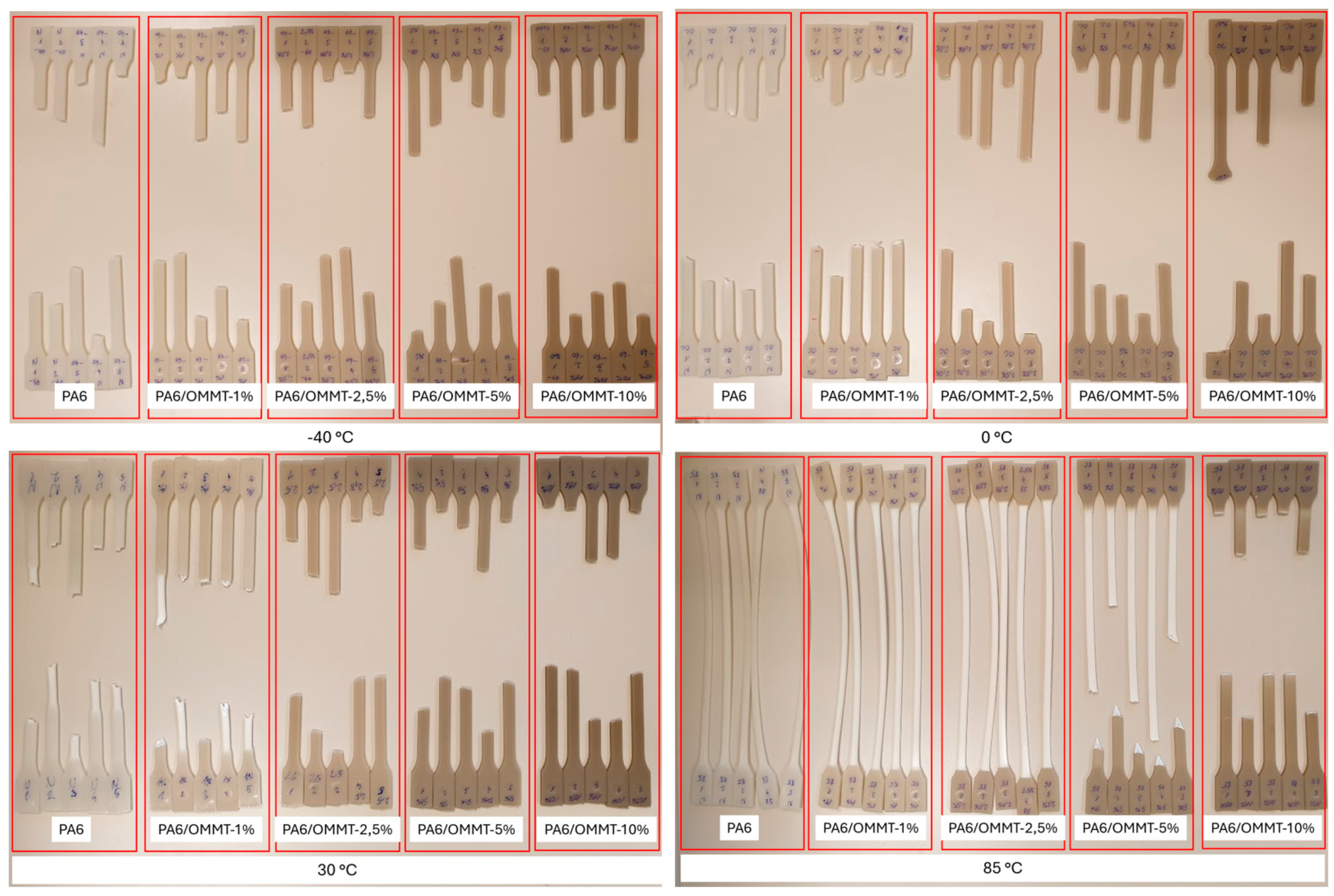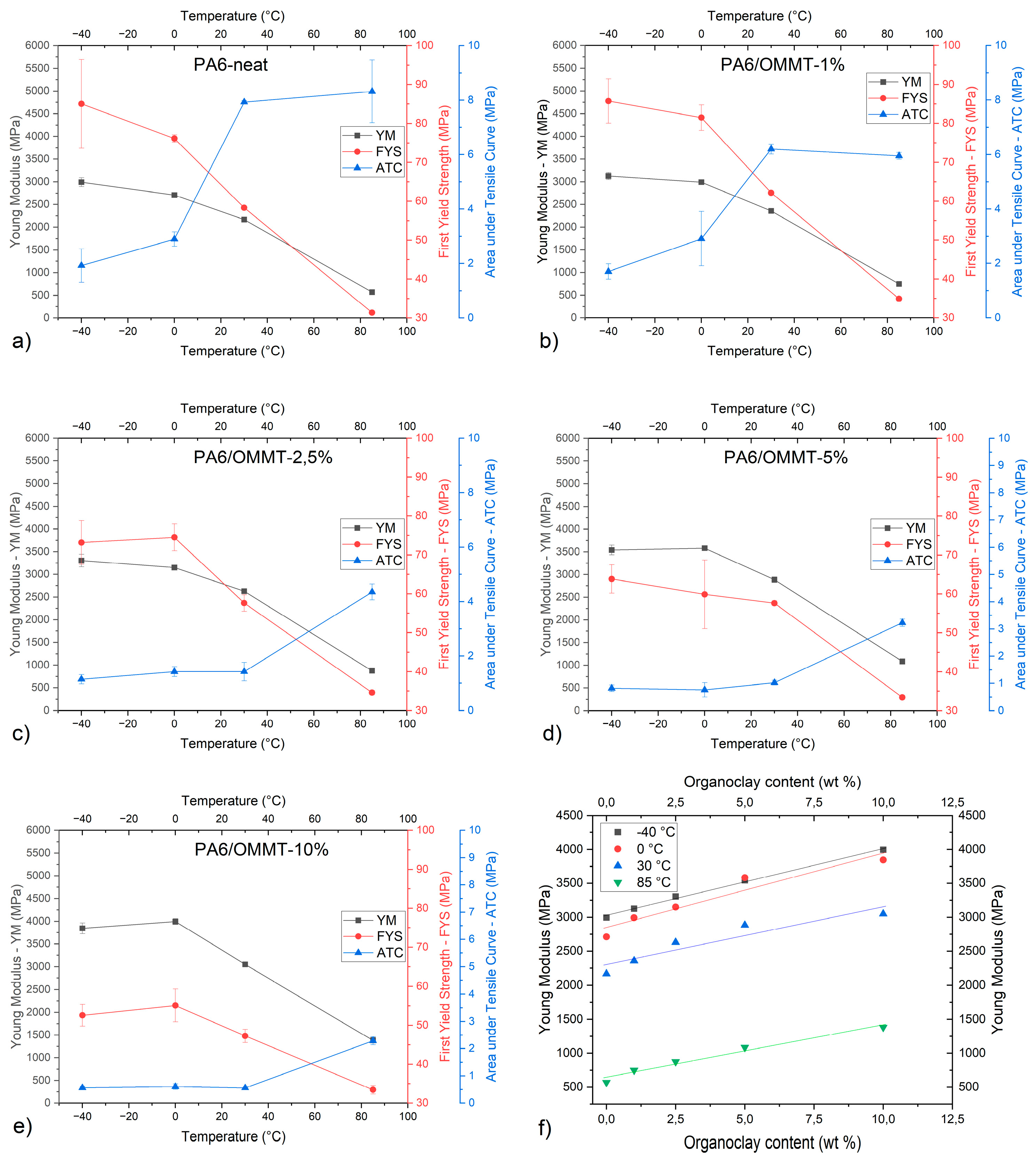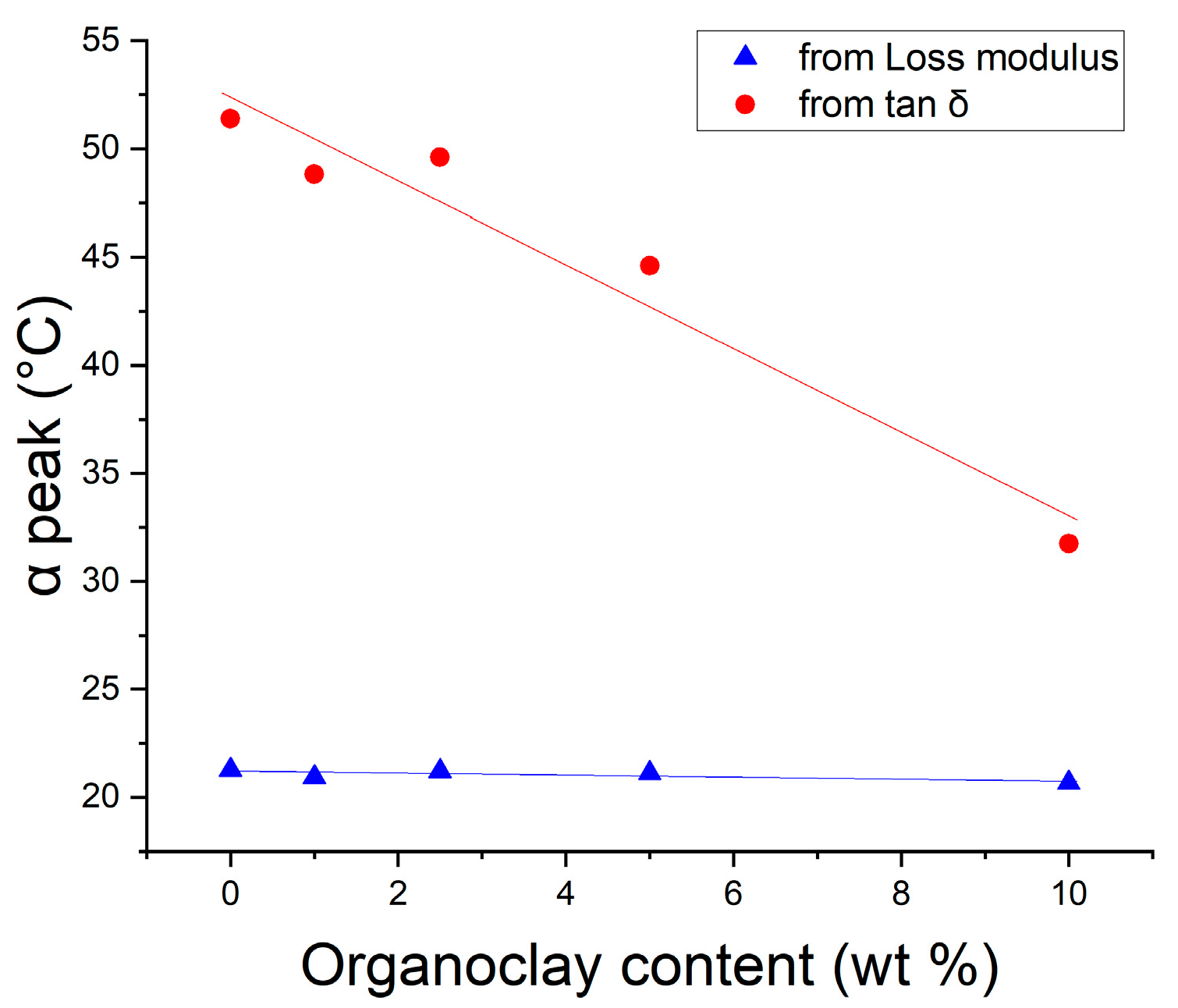Mechanical Properties of Clay-Reinforced Polyamide 6 Nanocomposite Liner Materials of Type IV Hydrogen Storage Vessels
Abstract
:1. Introduction
2. Materials and Methods
2.1. Sample Preparation
2.2. Tensile Test
2.3. Dynamic Mechanical Analysis
3. Results and Discussion
3.1. Mechanical Properties
3.2. Dynamic Mechanical Properties
4. Conclusions
Author Contributions
Funding
Data Availability Statement
Acknowledgments
Conflicts of Interest
References
- Barthelemy, H.; Weber, M.; Barbier, F. Hydrogen Storage: Recent Improvements and Industrial Perspectives. Int. J. Hydrogen Energy 2017, 42, 7254–7262. [Google Scholar] [CrossRef]
- Alves, M.P.; Gul, W.; Junior, C.A.C.; Ha, S.K. A Review on Industrial Perspectives and Challenges on Material, Manufacturing, Design and Development of Compressed Hydrogen Storage Tanks for the Transportation Sector. Energies 2022, 15, 5152. [Google Scholar] [CrossRef]
- Wolf, C.; Angellier-Coussy, H.; Gontard, N.; Doghieri, F.; Guillard, V. How the Shape of Fillers Affects the Barrier Properties of Polymer/Non-Porous Particles Nanocomposites: A Review. J. Membr. Sci. 2018, 556, 393–418. [Google Scholar] [CrossRef]
- Frounchi, M.; Dourbash, A. Oxygen Barrier Properties of Poly(Ethylene Terephthalate) Nanocomposite Films. Macromol. Mater. Eng. 2009, 294, 68–74. [Google Scholar] [CrossRef]
- Balasooriya, W.; Clute, C.; Schrittesser, B.; Pinter, G. A Review on Applicability, Limitations, and Improvements of Polymeric Materials in High-Pressure Hydrogen Gas Atmospheres. Polym. Rev. 2022, 62, 175–209. [Google Scholar] [CrossRef]
- Sun, Y.; Lv, H.; Zhou, W.; Zhang, C. Research on Hydrogen Permeability of Polyamide 6 as the Liner Material for Type Ⅳ Hydrogen Storage Tank. Int. J. Hydrogen Energy 2020, 45, 24980–24990. [Google Scholar] [CrossRef]
- Blanc-Vannet, P.; Papin, P.; Weber, M.; Renault, P.; Pepin, J.; Lainé, E.; Tantchou, G.; Castagnet, S.; Grandidier, J.-C. Sample Scale Testing Method to Prevent Collapse of Plastic Liners in Composite Pressure Vessels. Int. J. Hydrogen Energy 2019, 44, 8682–8691. [Google Scholar] [CrossRef]
- ISO 23273; Global Technical Regulation No. 13, Global Technical Regulation on Hydrogen and Fuel Cell Vehicles. European Union: Luxembourg, 2013.
- CELEX: 42019X0795; Regulation No. 134 of the Economic Commission for Europe of the United Nations (UN/ECE) Uniform Provisions Concerning the Approval of Motor Vehicles and Their Components with Regard to the Safety-Related Performance of Hydrogen-Fuelled Vehicles (HFCV). European Union: Luxembourg, 2019.
- Adams, P.; Bengaouer, A.; Cariteau, B.; Molkov, V.; Venetsanos, A.G. Allowable Hydrogen Permeation Rate from Road Vehicles. Int. J. Hydrogen Energy 2011, 36, 2742–2749. [Google Scholar] [CrossRef]
- Kis, D.I.; Kókai, E. A Review on the Factors of Liner Collapse in Type IV Hydrogen Storage Vessels. Int. J. Hydrogen Energy 2023. [CrossRef]
- Gupta, B.; Lacrampe, M.-F.; Krawczak, P. Polyamide-6/Clay Nanocomposites: A Critical Review. Polym. Polym. Compos. 2006, 14, 13–38. [Google Scholar] [CrossRef]
- Fujiwara, H.; Ono, H.; Onoue, K.; Nishimura, S. High-Pressure Gaseous Hydrogen Permeation Test Method—Property of Polymeric Materials for High-Pressure Hydrogen Devices (1)-. Int. J. Hydrogen Energy 2020, 45, 29082–29094. [Google Scholar] [CrossRef]
- Adame, D.; Beall, G. Direct Measurement of the Constrained Polymer Region in Polyamide/Clay Nanocomposites and the Implications for Gas Diffusion. Appl. Clay Sci. 2009, 42, 545–552. [Google Scholar] [CrossRef]
- Nielsen, L.E. Models for the Permeability of Filled Polymer Systems. J. Macromol. Sci. Part A—Chem. 1967, 1, 929–942. [Google Scholar] [CrossRef]
- Kun, K.; Szabó, L.; Varga, E.; Kis, D.I. Development of a Hydrogen Fuel Cell Prototype Vehicle Supported by Artificial Intelligence for Green Urban Transport. Energies 2024, 17, 1519. [Google Scholar] [CrossRef]
- Shan, G.-F.; Yang, W.; Yang, M.; Xie, B.; Feng, J.; Fu, Q. Effect of Temperature and Strain Rate on the Tensile Deformation of Polyamide 6. Polymer 2007, 48, 2958–2968. [Google Scholar] [CrossRef]
- Varlot, K.; Reynaud, E.; Kloppfer, M.H.; Vigier, G.; Varlet, J. Clay-Reinforced Polyamide: Preferential Orientation of the Montmorillonite Sheets and the Polyamide Crystalline Lamellae. J. Polym. Sci. Part B Polym. Phys. 2001, 39, 1360–1370. [Google Scholar] [CrossRef]
- Masenelli-Varlot, K.; Reynaud, E.; Vigier, G.; Varlet, J. Mechanical Properties of Clay-reinforced Polyamide. J. Polym. Sci. Part B Polym. Phys. 2002, 40, 272–283. [Google Scholar] [CrossRef]
- Bureau, M.N.; Denault, J.; Cole, K.C.; Enright, G.D. The Role of Crystallinity and Reinforcement in the Mechanical Behavior of Polyamide-6/Clay Nanocomposites. Polym. Eng. Sci. 2002, 42, 1897–1906. [Google Scholar] [CrossRef]
- Pramoda, K.P.; Liu, T. Effect of Moisture on the Dynamic Mechanical Relaxation of Polyamide-6/Clay Nanocomposites. J. Polym. Sci. Part B Polym. Phys. 2004, 42, 1823–1830. [Google Scholar] [CrossRef]
- Liu, Y.; Jiang, S.; Yan, W.; Qin, J.; He, M.; Qin, S.; Yu, J. Enhanced Mechanical and Thermal Properties of Polyamide 6/p (N-(4-F-Phenylmaleimide)–Alt-Styrene) Composites Based on Interfacial Complexation Inducing Crystal Transformation. Polymer 2021, 214, 123237. [Google Scholar] [CrossRef]
- Menczel, J.D.; Prime, R.B. Thermal Analysis of Polymers; Wiley: Hoboken, NJ, USA, 2009. [Google Scholar]
- Bata, A.; Gerse, P.; Slezák, E.; Ronkay, F. Time- and Temperature-Dependent Mechanical and Rheological Behaviours of Injection Moulded Biodegradable Organoclay Nanocomposites. Adv. Ind. Eng. Polym. Res. 2023. [Google Scholar] [CrossRef]
- Balachandran, M.; Bhagawan, S.S. Studies on Acrylonitrile—Butadiene Copolymer (NBR) Layered Silicate Composites: Mechanical and Viscoelastic Properties. J. Compos. Mater. 2011, 45, 2011–2022. [Google Scholar] [CrossRef]





Disclaimer/Publisher’s Note: The statements, opinions and data contained in all publications are solely those of the individual author(s) and contributor(s) and not of MDPI and/or the editor(s). MDPI and/or the editor(s) disclaim responsibility for any injury to people or property resulting from any ideas, methods, instructions or products referred to in the content. |
© 2024 by the authors. Licensee MDPI, Basel, Switzerland. This article is an open access article distributed under the terms and conditions of the Creative Commons Attribution (CC BY) license (https://creativecommons.org/licenses/by/4.0/).
Share and Cite
Kis, D.I.; Bata, A.; Takács, J.; Kókai, E. Mechanical Properties of Clay-Reinforced Polyamide 6 Nanocomposite Liner Materials of Type IV Hydrogen Storage Vessels. Nanomaterials 2024, 14, 1385. https://doi.org/10.3390/nano14171385
Kis DI, Bata A, Takács J, Kókai E. Mechanical Properties of Clay-Reinforced Polyamide 6 Nanocomposite Liner Materials of Type IV Hydrogen Storage Vessels. Nanomaterials. 2024; 14(17):1385. https://doi.org/10.3390/nano14171385
Chicago/Turabian StyleKis, Dávid István, Attila Bata, János Takács, and Eszter Kókai. 2024. "Mechanical Properties of Clay-Reinforced Polyamide 6 Nanocomposite Liner Materials of Type IV Hydrogen Storage Vessels" Nanomaterials 14, no. 17: 1385. https://doi.org/10.3390/nano14171385





